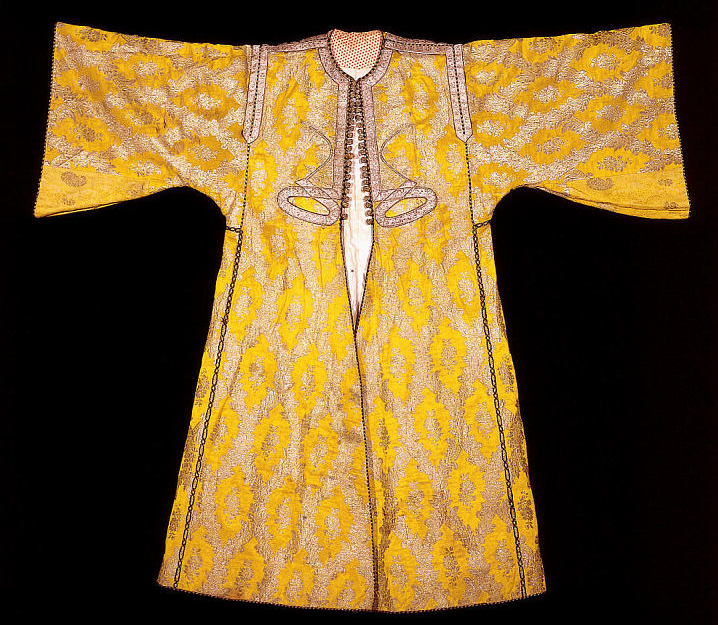Rooted in the vibrant tapestry of Moroccan history, the caftan stands as a testament to the country’s rich cultural heritage and artistic prowess. Tracing its origins back to the 12th-13th century Almohad dynasty, this iconic garment has evolved over the centuries, becoming a symbol of elegance, sophistication, and Moroccan identity.
In the French-Berber dictionary published in 1914, the caftan is defined as a garment typically made of silk, of Moroccan origin. (Page 55)

In the book « Descriptionary: A Thematic Dictionary » by Marc McCutcheon, « Caftan » is defined as « a full-length, robelike dress having embroidery around the neckline, a Moroccan design. » (Page 74)
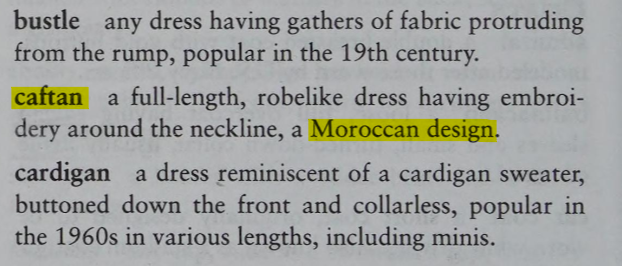
Below is a Moroccan caftan dating from the 18th century on the unesco website.
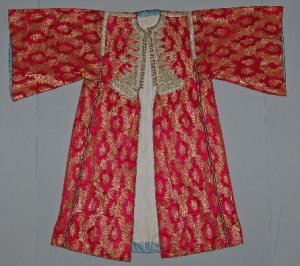
Emerging during a period of prosperity and artistic flourishing, the caftan quickly gained prominence as a garment of royalty and nobility. Its distinctive features, including its loose-fitting silhouette, long sleeves, and intricate frontal closure adorned with buttons (Akaad) or embroidery, set it apart as a masterpiece of Moroccan craftsmanship.

« Akaad » are buttons used to adorn traditional Moroccan caftans, and they have been utilized for centuries by the women of the city of Sefrou. These women ingeniously conceived these buttons in the shape of cherries, in reference to the emblematic fruit of their city, as confirmed and documented by UNESCO on its website.
Akaad are typically crafted from silk threads and are employed to fasten caftans, as well as to embellish scarves and bags. Their shape and texture imbue them with a particular elegance, rendering them an essential decorative element in the creation of Moroccan caftans, thus imparting a touch of refinement and sophistication.
It is noteworthy to mention that since 1920, the city of Sefrou has annually hosted a cherry festival, drawing visitors from all regions of Morocco. During this event, the residents of Sefrou celebrate their cherry production tradition, culminating in the crowning of the « Cherry Queen. »
The intricacies of this festival, including the magnificent caftans adorned in various hues and embroideries, along with the accompanying traditions, are detailed on the UNESCO website.
Crafted from sumptuous fabrics such as satin and silk, the caftan is a canvas for the artistry of Moroccan artisans. Lavish decorations, often featuring intricate patterns and vibrant colors, showcase the exceptional skills and creativity of these skilled individuals.
Initially reserved for the royal court and the elite, the caftan gradually permeated all levels of Moroccan society. Today, it is worn by women of all ages and backgrounds, serving as a versatile and elegant garment for both everyday wear and special occasions.
Recognizing its cultural significance, the caftan has been registered with the Islamic Educational, Scientific and Cultural Organization (ICESCO) as an ancestral Moroccan art.
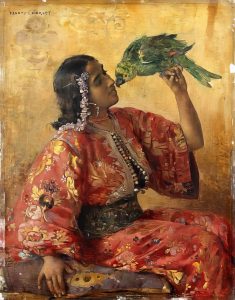
Beyond its historical significance, the caftan continues to be a cherished symbol of Moroccan identity. Its timeless elegance and versatility ensure its continued relevance in contemporary society, making it a treasured garment for generations to come.
To delve deeper into the rich history and artistry of the caftan, we journey to the captivating city of Fez, Morocco. A UNESCO World Heritage Site, Fez is renowned for its vibrant medina and its long-standing tradition of textile craftsmanship.

During the Almohad era, Fez served as a thriving hub for the textile industry, with over 3,000 weaving workshops scattered throughout its bustling quarters. The city’s skilled artisans produced exquisite textiles, including the sumptuous fabrics used to create caftans.


Here is the description of the imperial city of Fez in the book by the Italian novelist, journalist, poet, and short-story writer Edmondo De Amicis:
Under the rule of the Almohad dynasty, the city boasted thirty suburbs, eight hundred mosques, ninety thousand houses, ten thousand shops, eighty-six gates, expansive hospitals, magnificent baths, a vast library rich in precious Greek and Latin manuscripts, schools of philosophy, physics, astronomy, and languages, which attracted scholars and literati from across Europe and the Levant. It was known as the « Athens of Africa » and concurrently hosted a perpetual fair where goods from three continents converged. European commerce thrived in its bazaars and inns, while five hundred thousand inhabitants prospered amidst Moors, Arabs, Berbers, Jews,…

One of the most distinctive features of the caftan is its intricate embroidery, often featuring gold or silver thread. The art of embroidery in Fez, known as « Ntaa » or « Tarz Ntaa, » has its roots in the Almohad period.
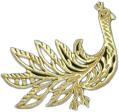

Historical references, such as those found in the writings of Abi Qasim Baghdadi Tamimi (1005-1087). Baghdadi’s admiration for this art form is evident in his poem, where he celebrates the intricate details that adorned textiles such as carpets and garments.


Today, the caftan continues to be a source of pride and inspiration for Moroccans around the world. Its enduring popularity is a testament to its timeless design, its rich cultural heritage, and the exceptional craftsmanship of Moroccan artisans.
« During special occasions, such as allegiance ceremonies, congratulations, or participation in the holy war in Andalusia, the sultans of the Almohad dynasty in Morocco would offer gifts and clothing to the Arabs who settled in Morocco.
Types of gifts included: complete outfits consisting of turbans, outer robes, bernous, undergarments, and scarves.
Quantity of gifts: Each knight received an undergarment, turban, mantle, thin linen robe, and shirt.
Special gifts for elders and princes: Luxurious clothing comprising six pieces. »
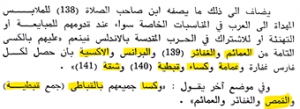
During his visits to the Moroccan Empire in 1732 and 1743, the Algerian doctor and traveler Abderzzaka Ben Hmadouche noted significant differences in decorations and caftans compared to those in his own country.


Moroccan embroidery has perennially captivated leading couturiers worldwide, spanning from Paul Poiret to Christian Dior, and from Balmain to Yves Saint Laurent…


« The Moroccans inspired France with their sharply designed embroidery done in dull glowing colors. »









In the present day, the Moroccan caftan has evolved alongside prevailing fashion trends, while maintaining its traditional essence. Moroccan designers have reinterpreted this timeless garment, infusing it with contemporary elements through innovative cuts, luxurious fabrics, and sophisticated embellishments.
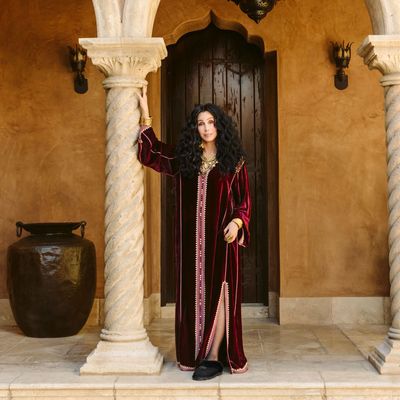
The enchantment of the Moroccan caftan transcends national borders, having ascended to the heights of the global fashion stage. Adorning the forms of luminaries at illustrious gatherings, it embodies versatility, seamlessly adapting to myriad occasions, whether steeped in tradition, exuding opulence at grand nuptial celebrations, or gracing the catwalks of modern fashion showcases.
Some malicious individuals use an excerpt from this book to distort the history of the Moroccan caftan by attributing it to the Ottoman Empire, deliberately ignoring the following page of the same book. Let’s explore both pages and you will understand everything. On page 136, we can read. Upon Abd al-Malik’s rise to power in 1576, a major change occurred in clothing customs dating back centuries. Having lived most of his life in Ottoman lands, this prince chose to adopt and even impose Ottoman clothing customs on his subjects.

However, as early as page 137, we discover that Sultan Ahmad al-Mansur’s accession to power in 1578 marked a return to local clothing traditions. This return is part of his Khalifist belief, as highlighted by a reporter from the first Spanish embassy in Morocco at the time of Al-Mansour in 1579. He asserts that Al-Mansour wore Moroccan white clothes with a turban on his head. This important information confirms that a few months after his accession to power, the sultan reinstated white as a symbol of his authority. The use of the term “Moroccan” to describe the sultan’s clothes is significant, as it underscores the contrast with the “Turkish” clothing style of his predecessor.


Al-Mansour’s willingness to follow this path illustrates his independence and commitment to ancient traditions. White was then adopted for meetings and official celebrations. This clothing trend then definitively imposed itself, remaining in use to this day. The sultan wore wide trousers tightened at the waist by a silk belt embroidered on the sides, as well as a shirt with tight sleeves and buttons at the wrist level. Over it, he wore a caftan, a kind of long robe with wide sleeves called “al-Mansouria”, specially made for him. Over all this, he wore a selham, a wide sleeveless cape with a head cover.
